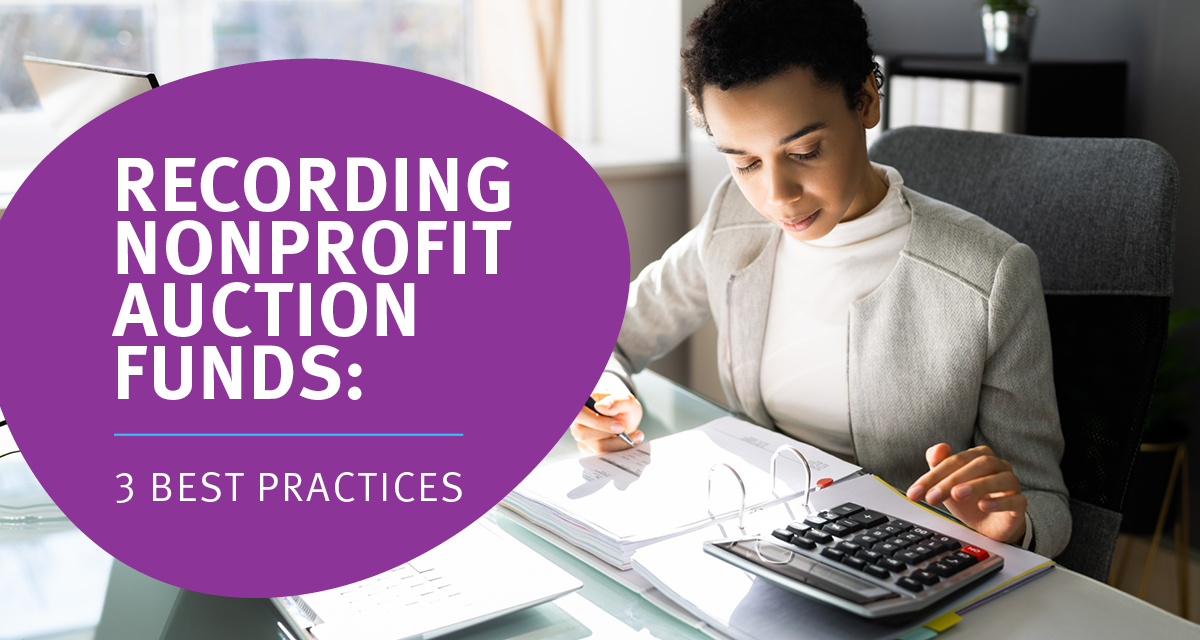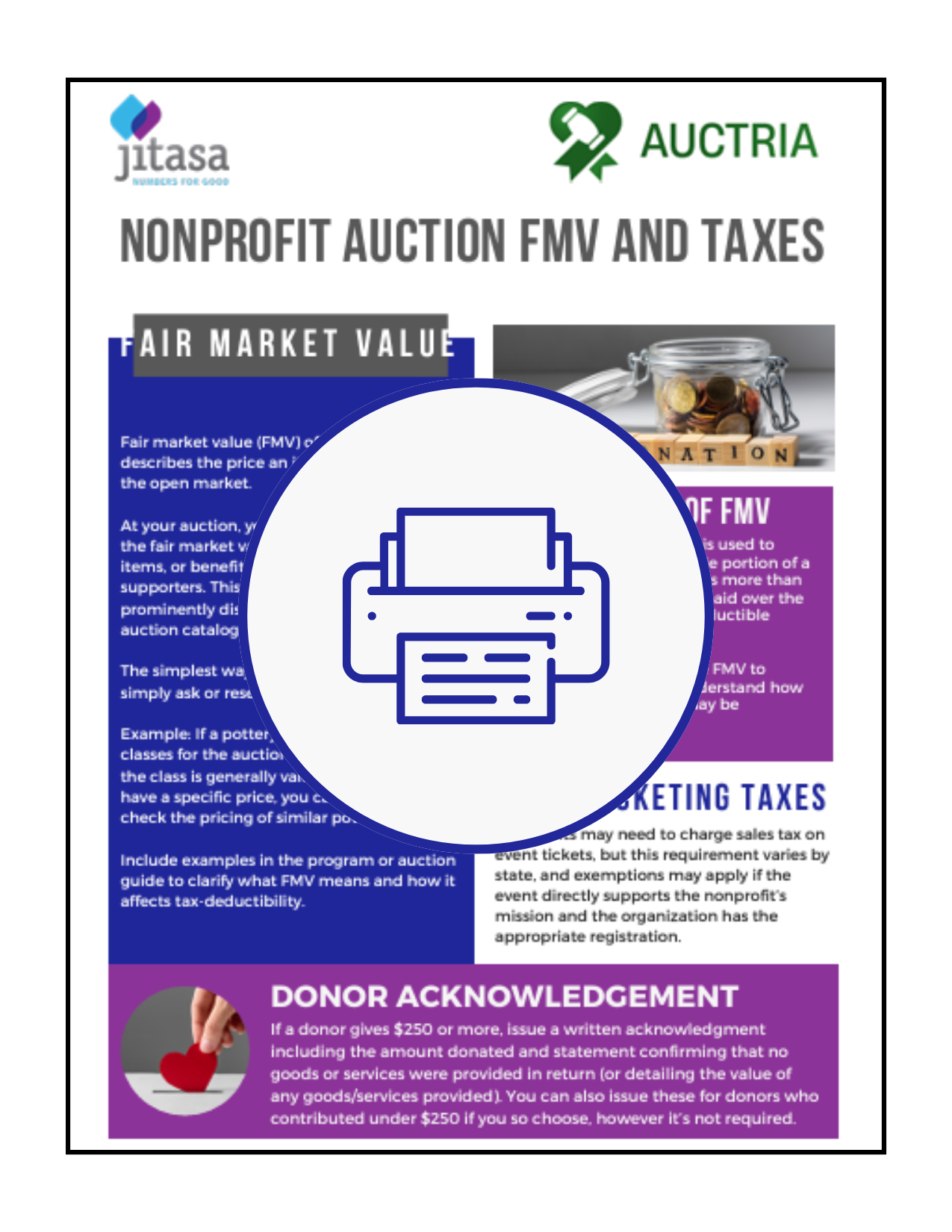If you’re in charge of planning fundraising events at your nonprofit, you’ve probably hosted (or at least considered hosting) an auction. Auctions stand out among fundraising events for their flexibility in format and compatibility with many other types of events, from galas to golf tournaments.
But with this flexibility comes a challenge: figuring out how to record all of the funds associated with your auction. At an auction, supporters can contribute in multiple ways—the same individual can buy a ticket, win auction items, and make a donation. Add in sponsorships, in-kind donations, and the upfront costs of event planning, and your financial data can get complicated quickly.
However, tracking all of your funding is essential for keeping your nonprofit accounting system organized and accurately reporting your revenue and expenses at the end of the fiscal year. To help you record your auction funds, this guide will walk through three best practices to implement at your organization. Let’s dive in!
1. Correctly Track In-Kind Donation Totals
To procure appealing auction items with minimal upfront costs, many nonprofits solicit in-kind donations. For these non-cash gifts, you still need to record their monetary value to comply with nonprofit fundraising and accounting guidelines.
In-kind contributions also require a different recordkeeping process from financial gifts. Here are some tips to accurately record in-kind donations you collect in advance of your auction:
- Know each item’s fair market value (FMV). For some goods, you can simply look up the item’s retail price to discover its FMV. However, one-of-a-kind goods and experiences are often more complicated to value. For these prizes, research comparable items online or ask the provider to estimate the FMV.
- Record each in-kind donation as a debit and a credit. Note the FMV in both columns of your nonprofit’s transaction records to indicate that in-kind gifts result in a net zero gain in cash for your organization. This also ensures you record the debit of acquiring an asset and the credit of receiving donation revenue equivalent to the item.
- Adjust your record of each item after the event. Once an item sells at auction, update your transaction record. Credit the asset acquisition side of the transaction and debit the donation revenue side to show that the item is no longer in your organization’s possession. Even if an item is quickly added and removed due to a fast sale, all associated transactions should still be recorded.
- Total all of your in-kind donation values. Nonprofits that receive $25,000 or more in in-kind donations during a single fiscal year are required to file Form 990M with the IRS. Keep careful records of your donated auction items’ total value, along with any other in-kind contributions you receive throughout the year, so you know which forms to complete during tax season.
The best way to ensure your in-kind donations are tracked correctly is to work with a nonprofit accountant. These professionals can help you navigate the double-entry system and ensure you have a record of every transaction involved in the item procurement process. They can also fill out Form 990M for you to reduce your team’s stress come tax season.
Understanding Fair Market Value and Taxes
Fair market value (FMV) of auction items describes the price an item would sell for on the open market.
For tax purposes, the FMV is used to calculate the tax-deductible portion of a winning bid. If a bidder pays more than the FMV, only the amount paid over the FMV is considered tax-deductible. This means that if an item’s FMV is $1,000 and a donor places a winning bid of $3,000, they can claim they made a $2,000 donation on their taxes.
Many charity auction sites and auction software platforms will provide tools for you to record details about each item, including their FMVs. This allows you to maintain better records and help price your items starting bids, as most nonprofits use FMV to determine bidding increments.
2. Categorize Event Revenue and Expenses
In addition to tracking in-kind donations, you also need to organize the rest of your auction revenue and expenses so that you can report them accurately in your year-end financial statements.
To gain a better understanding of your event revenue, it’s effective to categorize it by source, such as:
- Ticket sales
- Auction item purchases
- Additional individual donations
- Contributions from financial sponsors
According to Jitasa, there are two primary ways your nonprofit can organize its expenses. Natural expense categories break down costs based on the nature of the transaction, while functional expense categories arrange them according to how your organization used the money.
For an auction, nearly all of your expenses will fall into the functional category of fundraising costs (as opposed to administrative or program expenses). However, your natural expenses may include a variety of payments, such as:
- Venue rental, decorations, and equipment
- Catering and entertainment for event attendees
- Marketing content creation
- Fundraising software fees
- Purchases of any auction items that weren’t donated
When filing your annual tax returns, you’ll report your auction expenses based on their function. However, it’s also helpful to keep an internal record of your natural expenses. This way, when you plan future auctions, you can reference your past spending and look for ways to reduce upfront costs.
3. Issue Donation Acknowledgments
In addition to updating your accounting system, another important post-auction responsibility is recognizing the supporters who contributed to your event. Your auction donation acknowledgments serve two purposes:
- Thanking each supporter for their unique contributions. As eCardWidget’s guide to donor retention explains, prompt and personalized thank-you messages are essential for retaining donors over time. Mentioning the different ways a participant contributed to your event—buying a ticket, purchasing auction items, making additional donations, etc.—shows that you value their individual contributions.
- Providing documentation for tax deductions. If a supporter pays more than the FMV for an auction item, the excess amount is considered a tax-deductible charitable contribution. Additional monetary gifts made during your auction are also tax deductible, as are in-kind donations of auction items. Your nonprofit needs to issue each donor a written acknowledgment for contributions of $250 or more so they can claim them as tax deductions. However, it’s best practice to provide donation receipts for all gifts, regardless of monetary value.
In your donor database, make note of how each event participant contributed to your auction and whether you sent them a donation acknowledgment to ensure no supporters are missed.
Properly accounting auction funds is essential not only for ensuring compliance with nonprofit regulations, but also for improving your donor retention and event planning strategies going forward. Use the tips in this guide to get started, and don’t hesitate to reach out to a nonprofit financial expert, if you need additional help with any aspect of recording or reporting your auction revenue and expenses.
Special thanks to Jon Osterburg for the expert advice. Jon has spent the last nine years helping more than 100 nonprofits around the world with their finances as a leader at Jitasa, an accounting firm that offers bookkeeping and accounting services to not for profit organizations.

